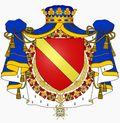Noailles (noble family)
Noailles is the name of an old French aristocratic family that comes from Noailles in the province of Limousin and got its name from a lordship near Brives in the Corrèze department who was elevated to a duchy in 1663 and owned it as early as the 11th century.
Representative
Its first important representative was Antoine de Noailles (1504–1562), Admiral of France and Ambassador to England for three important years, 1553–1556. His son was Henri de Noailles (1554-1623), military leader in the Wars of Religion. He was made Duke of Ayen by Henry IV in 1593. The grandson of the first count was Anne de Noailles († 1678). He played an important role in the Fronde and the first years of the reign of Louis XIV , became captain general of the newly acquired province of Roussillon and, in 1663, made Duke of Noailles and Peer of France .
The first duke's two sons led the family to the height of their fame. The eldest, Anne-Jules de Noailles , (1650-1708) was one of the most important generals of the late reign of Louis XIV. He commanded his régiment de Noailles in the War of the Spanish Succession and in 1693 became Marshal of France . A younger son, Louis-Antoine de Noailles (1651-1720), Duke of Saint-Cloud, became Archbishop of Paris in 1695 and Cardinal in 1699 .
The name Noailles appears again and again in French history throughout the 18th century with almost confusing repetition. Adrien-Maurice de Noailles (1678–1766), the third Duke, served in all of Louis XV's major wars . in Italy and Germany . He became Marshal of France in 1734. His last command was the Battle of Dettingen in the War of the Austrian Succession in 1743 . He married Marie-Françoise d'Aubigné, a niece of Madame de Maintenon , and had two sons with her who also became Marshals of France.
The elder, Louis de Noailles (1713–1793), who carried the title of duc d'Ayen until his father's death in 1766 , before being succeeded as the 4th duc de Noailles , fought in almost all wars of the 18th century. Although he was not particularly distinguished, he was appointed Marshal in 1755. He refused to emigrate during the French Revolution and only escaped the guillotine because he died in 1793 before the reign of terror reached its peak. On 4th Thermidor III (July 22, 1795) his wife, the 70-year-old Duchess of Noailles, her daughter-in-law, the Duchess of Ayen and her granddaughter, the vicomtesse de Noailles , were executed.
Paul-François de Noailles (1739-1824), the 5th Duke, also served in the army, but then turned to the natural sciences and in 1777 was elected to the Académie des Sciences . He became Duke of Ayen in 1766 after the death of his grandfather and Duke of Noailles after his father's death in 1793. He hademigrated to Switzerland in1792and did not return until the Restoration in 1814 to take his place as a pair.
The brother of the 5th Duke, Emmanuel Marie Louis de Noailles (1743–1822), marquis de Noailles , was ambassador in Amsterdam from 1770 to 1776 , from 1776 to 1783 in London and from 1783 to 1792 in Vienna .
Since the 5th Duke had no son, the title of duke was passed on to his great-nephew Paul de Noailles (1802-1885), a historian and writer who was elected to the Académie française in 1849 . His second son Emmanuel-Henri-Victurnien, marquis de Noailles (1830-1909) became French ambassador to Washington, DC in 1872 , ambassador to Rome in 1873 , to Constantinople in 1882 and in 1886 he took his leave. He made himself known through works about Poland ("La Pologne et ses frontières", Paris 1863; "La poésie polonaise", Paris 1866, and "Henri de Valois et la Pologne en 1572", Paris 1867, 3 volumes).
The Noailles-Mouchy branch
Another branch of the family deserves attention. Philippe de Noailles, duc de Mouchy , since 1750 duc de Mouchy (1715–1794), was a younger brother of the 4th Duke and a more important soldier than him. He served in the Battle of Minden and other campaigns and became Marshal of France on the same day as his brother in 1775. He was a knight of the Order of the Golden Fleece and was in great favor at court for a long time; his wife Anne-Claude-Louise d'Arpajon was the first lady-in-waiting of Queen Marie Antoinette and was known as Madame l'Etiquette . This proximity to the royal court brought both spouses under the guillotine on June 27, 1794 . Her two sons, Philippe-Louis-Marc-Antoine de Noailles , prince de Poix (1752-1819) and Louis-Marie de Noailles , vicomte de Noailles (1756-1804), became members of the constituent assembly . The latter was also active as a general, fought under Rochambeau in Santo Domingo and died in Havana .
Other members of the family
- Pierre-Bienvenu Noailles (1793–1861), French priest
- Anna de Noailles (Princess Anna Élisabeth Bibesco de Brancovan, Comtesse de Noailles; 1876–1933), French poet and writer
- Marie-Victoire de Noailles (1688–1766), French nobleman
- Marie-Laure de Noailles , née Bischoffsheim (1902–1970), French writer, poet and painter; as well as art patrons of the avant-garde



